From Sanskrit to English
Sanskrit pronunciation: Utthita Parsvakonasana (oo-TEE-tah parsh-vah-cone-AHS-anna)
Meaning: utthita = extended; parsva = side ; kona = angle
Known in English as Extended Side Angle Pose, this powerful standing asana first appears in Krisnamacharya’s teachings during the 20th century. While, on the surface, this pose seems to be about stretching our side body, the more we practice it and explore it, the more we understand this is an actual invitation to open our bodies and expose our vulnerability.
Benefits of Utthita Parsvakonasana
+ Strengthens the leg muscles and joints, the spine, and the shoulders
+ Stretches the legs, groins, hips, spine, torso, shoulders and neck
+ Opens the chest and hips
+ Stimulates the organs in the abdominal cavity
+ Increases lung capacity
+ Improves stamina
+ Increases blood circulation in the sexual organs and boosts fertility
+ Alleviates lower back pain, constipation, menstrual cramps
Yoga for every BODY
In Utthita Parsvakonasana A we may easily be tempted to push ourselves beyond our limits. Indeed, there is a tendency to sink too deeply into our hips, overbend the front knee, or wish to touch the floor so badly that we end up closing our upper body instead of opening it. So, no matter where you may be in your yoga journey, let’s step back a little. Why don’t we take this as an opportunity to revise the correct alignment and make the most out of this pose?
Standard Utthita Parsvakonasana A
1. In Ashtanga Yoga we start in Tadasana and step to the right, turning your body to face the longer edge of your mat. Your legs should be about 120-150 cm apart (depending on your height).
2. While your front foot should be parallel to the longer edge of your mat, your back foot should be parallel to the shorter edge. If you were to draw a straight line from the back of your front heel, it would come to bisect the inner arch of your back foot.
3. Bend your front knee so that it’s at a 90 degree angle, directly above your front heel, just like in Virabhadrasana II / B. Extend your back leg and let your back foot entirely touch the floor.
4. Root yourself through your feet, lift your knee caps, and allow for the inner thigh of your back leg to rotate slightly inside out.
5. Activate your mula bandha and uddiyana bandha. Lengthen through the sides of your body, and extend your arms out to the sides with your palms facing down.
6. Lean in with your upper body towards your front leg to place the palm of your front hand to the outside of your front foot.
7. Sweep your other arm towards the floor and up, just over your ear. Your body should form a straight line from the edge of your back foot to the fingertips of your top hand.
8. Pressing into the floor with your feet and hand, send your shoulders away from the ears, and gaze at the palm of your top hand.
Modification 1: Supporting the lower body
Using a chair and a blanket to support your front thigh will help relieve some of the body weight, giving you more freedom to correctly align your feet, hips and front knee.
A
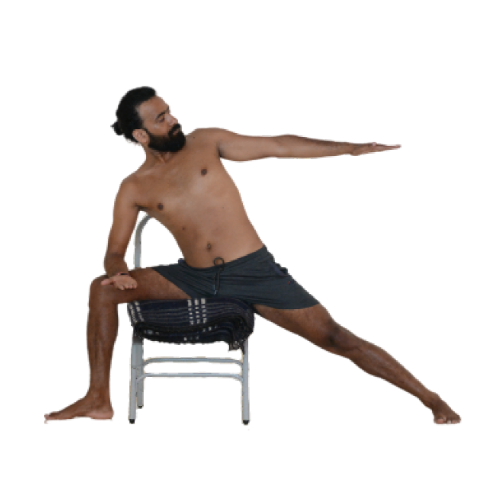
B
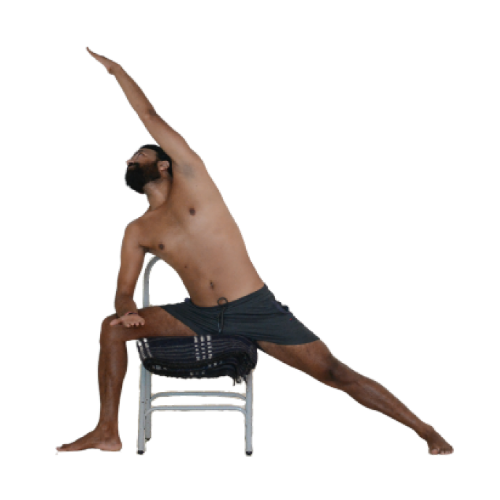
1. Set up a chair towards the front of your mat (leaving ⅔ free at the back) and have it face the longer edge of your mat. Place a blanket over its seat.
2. Take a step over the seat of the chair with your front leg. With your front foot parallel to the longer edge of your mat, pivot the ball of your back foot, and drop your heel at 90 degree angle. Your back foot should be parallel to the shorter edge of your mat.
3. Bend your front knee so that it’s at a 90 degree angle, directly above your front heel. The blanket should support your front thigh (adjust the height if needed). Extend your back leg, and let your back foot entirely touch the floor. Push through your feet to root yourself, lift your knee caps, and rotate your back thigh.
4. Activate your mula bandha and uddiyana bandha. Lengthen through the sides of your body, and extend your arms out to the sides with your palms facing down.
5. Lean in with your torso towards your front leg and place the forearm of your front arm right above your knee. Make sure your elbow is bent at a 90 degree angle and falls right below your shoulder.
6. Keep your other arm parallel to the floor and send your gaze towards your back hand (see picture A).
7. Once you are comfortable here, you can move your gaze to the front and sweep your back arm down and up to place it alongside your ear. Send your shoulders far from the ears and look at your front palm (see picture B).
Modification 2: Using a strap
Looping a strap around your hip crease helps lowering the front hip and pushing it back. It also facilitates the rotation taking place in the thigh of your back leg. If you can’t yet reach the floor or if you feel it forces you to close your shoulders, compromising the opening of your chest, place your upper arm right above your front knee.
C
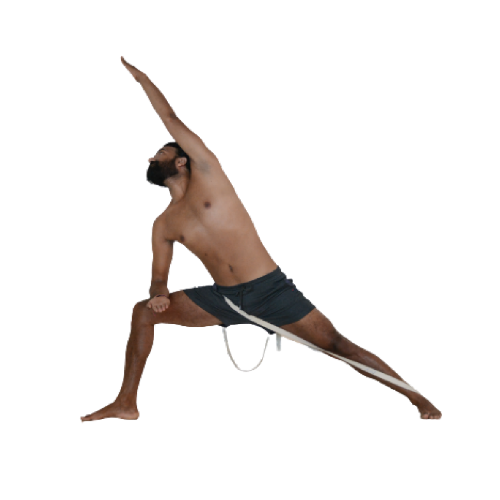
1. Take a strap and stand in Tadasana.
2. Step to the right, turning your body to face the longer edge of your mat. Your legs should be about 120-150 cm apart (depending on your height).
3. With your front foot parallel to the longer edge of your mat, turn your back foot in so that it’s parallel to the shorter edge of your mat. If you were to draw a line from your front heel to your back foot, it would come to bisect the inner arch of your back foot.
4. Place the strap beneath your back foot, grab both ends of the strap with your hands, and loop it tight around your front hip crease (it may take a few adjustments to find the perfect length).
5. Bend your front knee so that it’s at a 90 degree angle, directly above your front heel. Extend your back leg and let your back foot entirely touch the floor.
6. Root yourself through your feet, lift your knee caps, and allow for the inner thigh of your back leg to rotate slightly inside out.
7. Activate your mula bandha and uddiyana bandha. Lengthen through the sides of your body, and extend your arms out to the sides with your palms facing down.
8. Lean in with your upper body towards your front leg and place the forearm of your front arm right above your knee. Make sure your elbow is bent at a 90 degree angle and falls right below your shoulder.
9. Sweep your other arm towards the floor and up, just over your ear. Your body should form a straight line from the edge of your back foot to the fingertips of your top hand.
10. Pressing into the floor with your feet and hand, send your shoulders away from the ears, and gaze at the palm of your top hand.
Modification 3: Gaining a little height
If you can’t yet reach the floor with your hand but feel too comfortable with your upper arm resting above your front knee, using a block is a perfect in-between option!
D
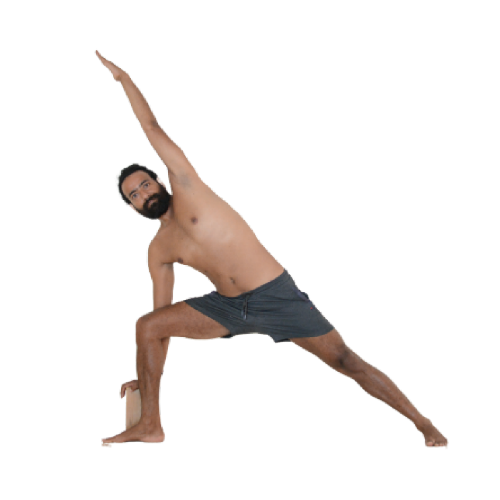
E
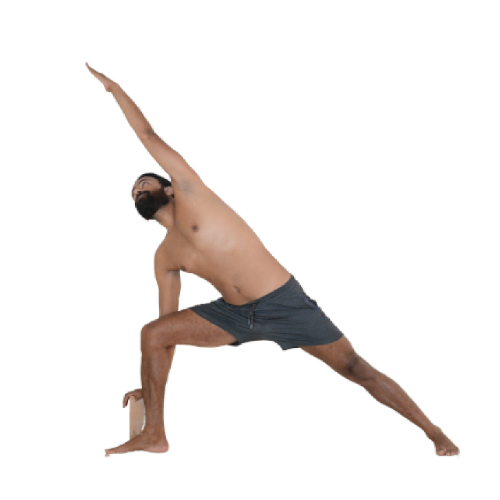
1. Place a block on its higher side to the outside of what will become your front foot.
2. Step back with your other leg and follow the instructions for Standard Utthita Parsvakonasana but instead of placing the palm of your front hand to the outside of your front foot, place it on the block.
3. Begin looking forward (see picture D). Then if your neck allows, look at the palm of your top hand for a deeper version of the pose (see picture E).
Interested in becoming a yoga teacher?
Newsletter
Upcoming events and latest blogs